Israeli vs Turkish Community Comparison
COMPARE
Israeli
Turkish
Social Comparison
Social Comparison
Israelis
Turks
6,737
SOCIAL INDEX
64.9/ 100
SOCIAL RATING
145th/ 347
SOCIAL RANK
9,373
SOCIAL INDEX
91.2/ 100
SOCIAL RATING
17th/ 347
SOCIAL RANK
Turkish Integration in Israeli Communities
The statistical analysis conducted on geographies consisting of 162,717,650 people shows a moderate positive correlation between the proportion of Turks within Israeli communities in the United States with a correlation coefficient (R) of 0.445. On average, for every 1% (one percent) increase in Israelis within a typical geography, there is an increase of 0.063% in Turks. To illustrate, in a geography comprising of 100,000 individuals, a rise of 1,000 Israelis corresponds to an increase of 63.4 Turks.
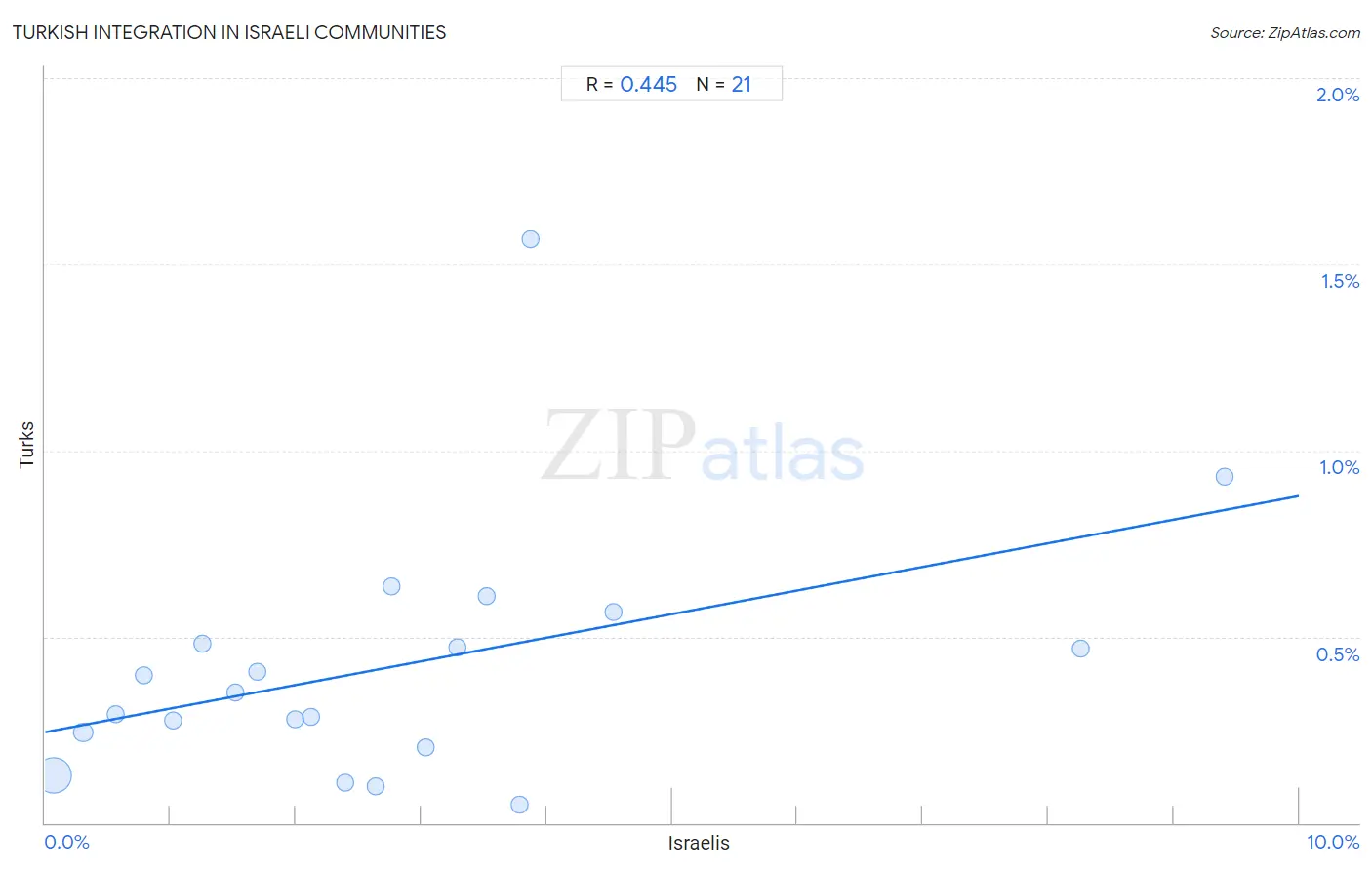
Israeli vs Turkish Income
When considering income, the most significant differences between Israeli and Turkish communities in the United States are seen in householder income under 25 years ($52,335 compared to $54,266, a difference of 3.7%), householder income ages 45 - 64 years ($114,186 compared to $117,814, a difference of 3.2%), and median household income ($96,552 compared to $99,389, a difference of 2.9%). Conversely, both communities are more comparable in terms of per capita income ($52,596 compared to $52,391, a difference of 0.39%), wage/income gap (27.4% compared to 27.7%, a difference of 1.1%), and median male earnings ($63,228 compared to $64,253, a difference of 1.6%).

| Income Metric | Israeli | Turkish |
| Per Capita Income | Exceptional $52,596 | Exceptional $52,391 |
| Median Family Income | Exceptional $118,577 | Exceptional $121,202 |
| Median Household Income | Exceptional $96,552 | Exceptional $99,389 |
| Median Earnings | Exceptional $52,937 | Exceptional $53,919 |
| Median Male Earnings | Exceptional $63,228 | Exceptional $64,253 |
| Median Female Earnings | Exceptional $43,852 | Exceptional $44,695 |
| Householder Age | Under 25 years | Average $52,335 | Exceptional $54,266 |
| Householder Age | 25 - 44 years | Exceptional $107,579 | Exceptional $110,318 |
| Householder Age | 45 - 64 years | Exceptional $114,186 | Exceptional $117,814 |
| Householder Age | Over 65 years | Exceptional $66,636 | Exceptional $68,037 |
| Wage/Income Gap | Tragic 27.4% | Tragic 27.7% |
Israeli vs Turkish Poverty
When considering poverty, the most significant differences between Israeli and Turkish communities in the United States are seen in married-couple family poverty (5.3% compared to 4.3%, a difference of 23.4%), family poverty (8.9% compared to 7.5%, a difference of 18.0%), and child poverty among boys under 16 (15.9% compared to 13.6%, a difference of 17.0%). Conversely, both communities are more comparable in terms of single mother poverty (28.0% compared to 26.4%, a difference of 5.9%), single male poverty (12.9% compared to 12.1%, a difference of 6.3%), and single female poverty (19.9% compared to 18.7%, a difference of 6.6%).
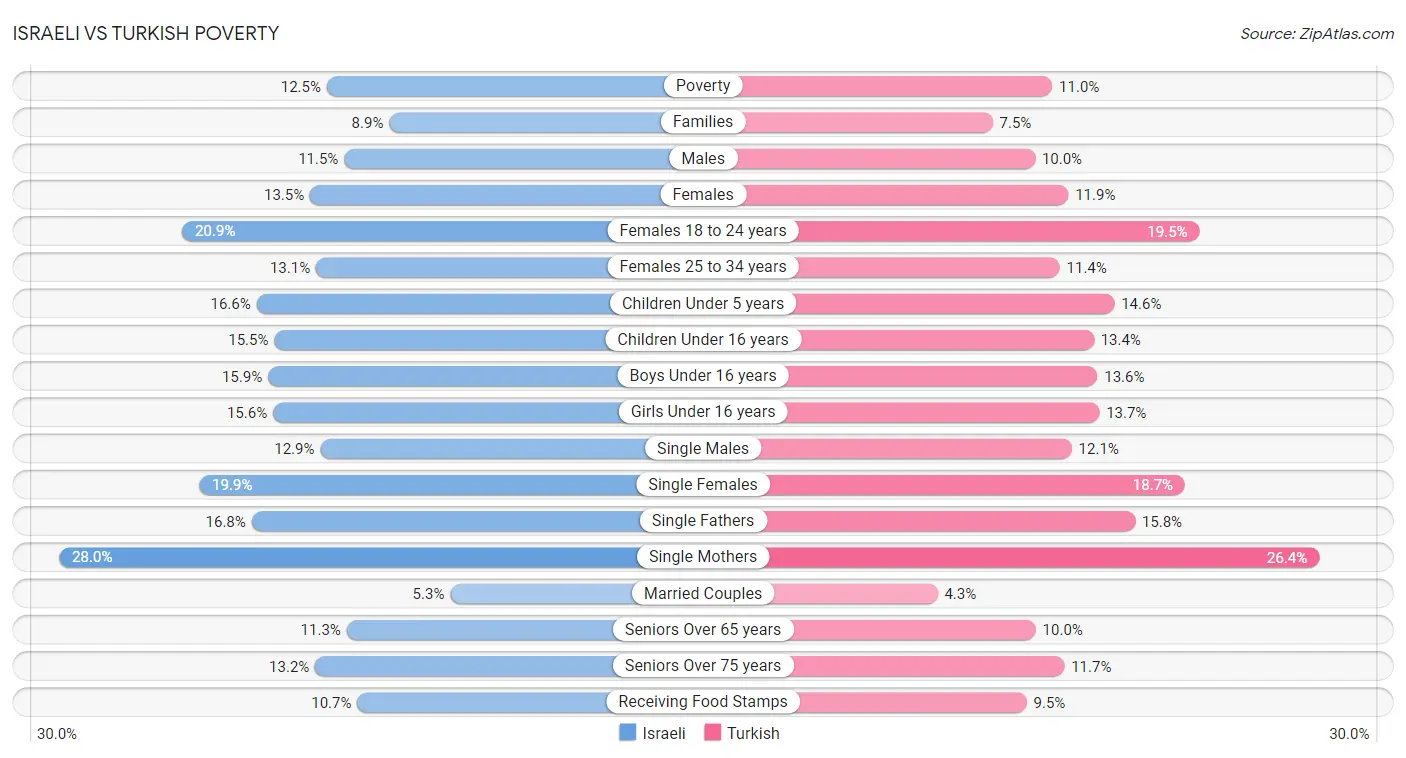
| Poverty Metric | Israeli | Turkish |
| Poverty | Fair 12.5% | Exceptional 11.0% |
| Families | Good 8.9% | Exceptional 7.5% |
| Males | Fair 11.5% | Exceptional 10.0% |
| Females | Average 13.5% | Exceptional 11.9% |
| Females 18 to 24 years | Tragic 20.9% | Exceptional 19.5% |
| Females 25 to 34 years | Excellent 13.1% | Exceptional 11.4% |
| Children Under 5 years | Excellent 16.6% | Exceptional 14.6% |
| Children Under 16 years | Excellent 15.5% | Exceptional 13.4% |
| Boys Under 16 years | Good 15.9% | Exceptional 13.6% |
| Girls Under 16 years | Excellent 15.6% | Exceptional 13.7% |
| Single Males | Average 12.9% | Exceptional 12.1% |
| Single Females | Exceptional 19.9% | Exceptional 18.7% |
| Single Fathers | Tragic 16.8% | Exceptional 15.8% |
| Single Mothers | Exceptional 28.0% | Exceptional 26.4% |
| Married Couples | Fair 5.3% | Exceptional 4.3% |
| Seniors Over 65 years | Poor 11.3% | Exceptional 10.0% |
| Seniors Over 75 years | Tragic 13.2% | Excellent 11.7% |
| Receiving Food Stamps | Exceptional 10.7% | Exceptional 9.5% |
Israeli vs Turkish Unemployment
When considering unemployment, the most significant differences between Israeli and Turkish communities in the United States are seen in unemployment among seniors over 75 years (7.4% compared to 8.6%, a difference of 15.9%), unemployment among women with children under 18 years (5.6% compared to 5.0%, a difference of 11.9%), and unemployment among ages 45 to 54 years (4.8% compared to 4.3%, a difference of 11.4%). Conversely, both communities are more comparable in terms of unemployment among women with children under 6 years (7.2% compared to 7.0%, a difference of 2.7%), unemployment among ages 20 to 24 years (10.6% compared to 10.3%, a difference of 3.2%), and unemployment among women with children ages 6 to 17 years (8.7% compared to 8.9%, a difference of 3.4%).
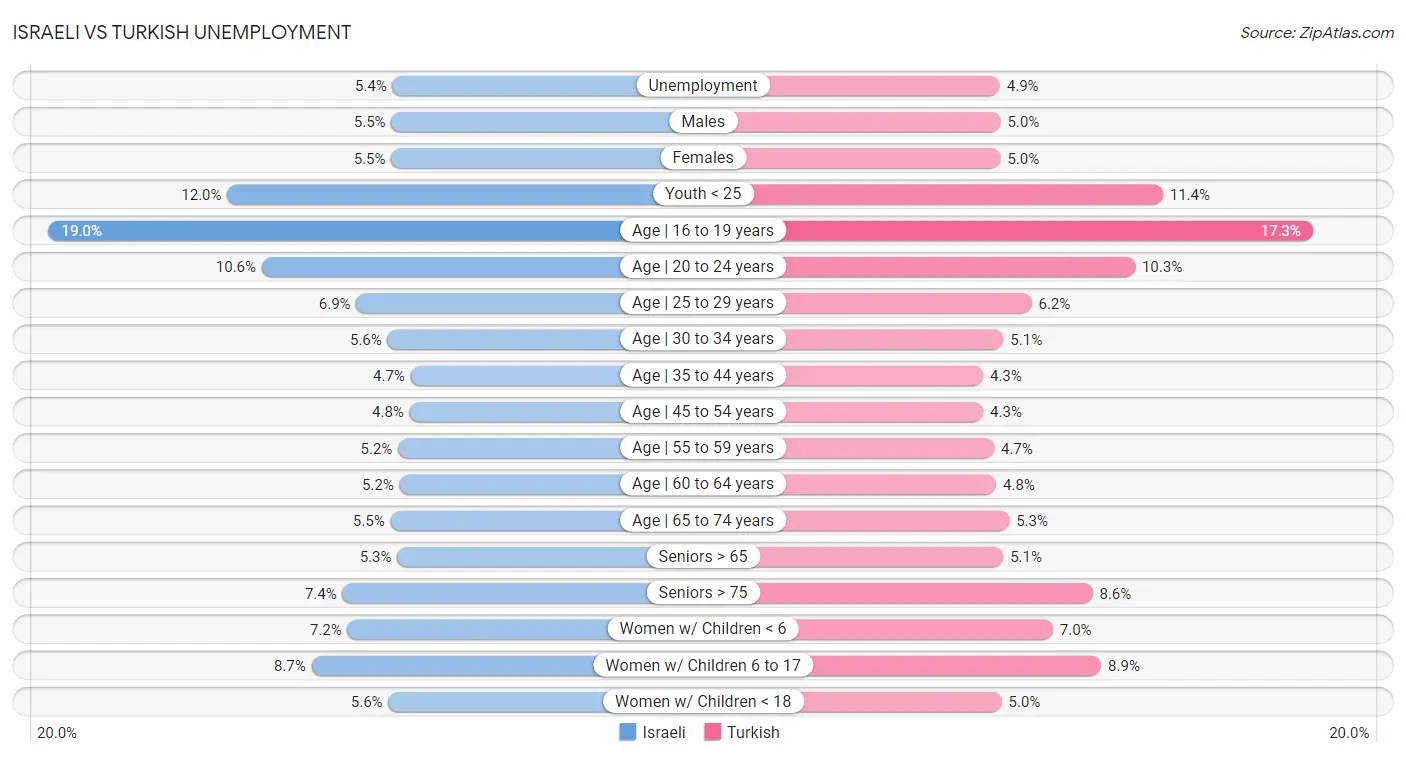
| Unemployment Metric | Israeli | Turkish |
| Unemployment | Tragic 5.4% | Exceptional 4.9% |
| Males | Tragic 5.5% | Exceptional 5.0% |
| Females | Tragic 5.5% | Exceptional 5.0% |
| Youth < 25 | Tragic 12.0% | Excellent 11.4% |
| Age | 16 to 19 years | Tragic 19.0% | Good 17.3% |
| Age | 20 to 24 years | Tragic 10.6% | Average 10.3% |
| Age | 25 to 29 years | Tragic 6.9% | Exceptional 6.2% |
| Age | 30 to 34 years | Poor 5.6% | Exceptional 5.1% |
| Age | 35 to 44 years | Fair 4.7% | Exceptional 4.3% |
| Age | 45 to 54 years | Tragic 4.8% | Exceptional 4.3% |
| Age | 55 to 59 years | Tragic 5.2% | Exceptional 4.7% |
| Age | 60 to 64 years | Tragic 5.2% | Excellent 4.8% |
| Age | 65 to 74 years | Tragic 5.5% | Good 5.3% |
| Seniors > 65 | Tragic 5.3% | Excellent 5.1% |
| Seniors > 75 | Exceptional 7.4% | Good 8.6% |
| Women w/ Children < 6 | Exceptional 7.2% | Exceptional 7.0% |
| Women w/ Children 6 to 17 | Exceptional 8.7% | Average 8.9% |
| Women w/ Children < 18 | Poor 5.6% | Exceptional 5.0% |
Israeli vs Turkish Labor Participation
When considering labor participation, the most significant differences between Israeli and Turkish communities in the United States are seen in in labor force | age 16-19 (32.4% compared to 35.4%, a difference of 9.2%), in labor force | age 20-24 (72.6% compared to 73.9%, a difference of 1.9%), and in labor force | age 25-29 (84.3% compared to 85.6%, a difference of 1.6%). Conversely, both communities are more comparable in terms of in labor force | age 20-64 (79.5% compared to 80.3%, a difference of 1.1%), in labor force | age 30-34 (84.7% compared to 85.7%, a difference of 1.2%), and in labor force | age 35-44 (84.1% compared to 85.1%, a difference of 1.2%).

| Labor Participation Metric | Israeli | Turkish |
| In Labor Force | Age > 16 | Good 65.2% | Exceptional 66.1% |
| In Labor Force | Age 20-64 | Fair 79.5% | Exceptional 80.3% |
| In Labor Force | Age 16-19 | Tragic 32.4% | Tragic 35.4% |
| In Labor Force | Age 20-24 | Tragic 72.6% | Tragic 73.9% |
| In Labor Force | Age 25-29 | Tragic 84.3% | Exceptional 85.6% |
| In Labor Force | Age 30-34 | Average 84.7% | Exceptional 85.7% |
| In Labor Force | Age 35-44 | Poor 84.1% | Exceptional 85.1% |
| In Labor Force | Age 45-54 | Fair 82.7% | Exceptional 83.8% |
Israeli vs Turkish Family Structure
When considering family structure, the most significant differences between Israeli and Turkish communities in the United States are seen in births to unmarried women (28.6% compared to 27.4%, a difference of 4.2%), single mother households (5.7% compared to 5.5%, a difference of 3.8%), and currently married (46.6% compared to 47.8%, a difference of 2.6%). Conversely, both communities are more comparable in terms of family households with children (27.5% compared to 27.4%, a difference of 0.15%), single father households (2.0% compared to 2.0%, a difference of 0.25%), and family households (63.1% compared to 63.6%, a difference of 0.82%).

| Family Structure Metric | Israeli | Turkish |
| Family Households | Tragic 63.1% | Tragic 63.6% |
| Family Households with Children | Average 27.5% | Average 27.4% |
| Married-couple Households | Good 46.7% | Exceptional 47.8% |
| Average Family Size | Average 3.23 | Tragic 3.16 |
| Single Father Households | Exceptional 2.0% | Exceptional 2.0% |
| Single Mother Households | Exceptional 5.7% | Exceptional 5.5% |
| Currently Married | Average 46.6% | Exceptional 47.8% |
| Divorced or Separated | Exceptional 11.3% | Exceptional 11.2% |
| Births to Unmarried Women | Exceptional 28.6% | Exceptional 27.4% |
Israeli vs Turkish Vehicle Availability
When considering vehicle availability, the most significant differences between Israeli and Turkish communities in the United States are seen in 4 or more vehicles in household (5.2% compared to 5.8%, a difference of 11.3%), 3 or more vehicles in household (16.8% compared to 18.4%, a difference of 10.0%), and no vehicles in household (12.4% compared to 11.7%, a difference of 6.5%). Conversely, both communities are more comparable in terms of 1 or more vehicles in household (87.7% compared to 88.4%, a difference of 0.86%), 2 or more vehicles in household (51.9% compared to 54.3%, a difference of 4.7%), and no vehicles in household (12.4% compared to 11.7%, a difference of 6.5%).

| Vehicle Availability Metric | Israeli | Turkish |
| No Vehicles Available | Tragic 12.4% | Tragic 11.7% |
| 1+ Vehicles Available | Tragic 87.7% | Tragic 88.4% |
| 2+ Vehicles Available | Tragic 51.9% | Poor 54.3% |
| 3+ Vehicles Available | Tragic 16.8% | Tragic 18.4% |
| 4+ Vehicles Available | Tragic 5.2% | Tragic 5.8% |
Israeli vs Turkish Education Level
When considering education level, the most significant differences between Israeli and Turkish communities in the United States are seen in professional degree (6.9% compared to 6.2%, a difference of 11.7%), no schooling completed (1.9% compared to 1.8%, a difference of 7.1%), and master's degree (20.3% compared to 19.9%, a difference of 2.2%). Conversely, both communities are more comparable in terms of nursery school (98.1% compared to 98.2%, a difference of 0.12%), kindergarten (98.1% compared to 98.2%, a difference of 0.12%), and 1st grade (98.1% compared to 98.2%, a difference of 0.13%).
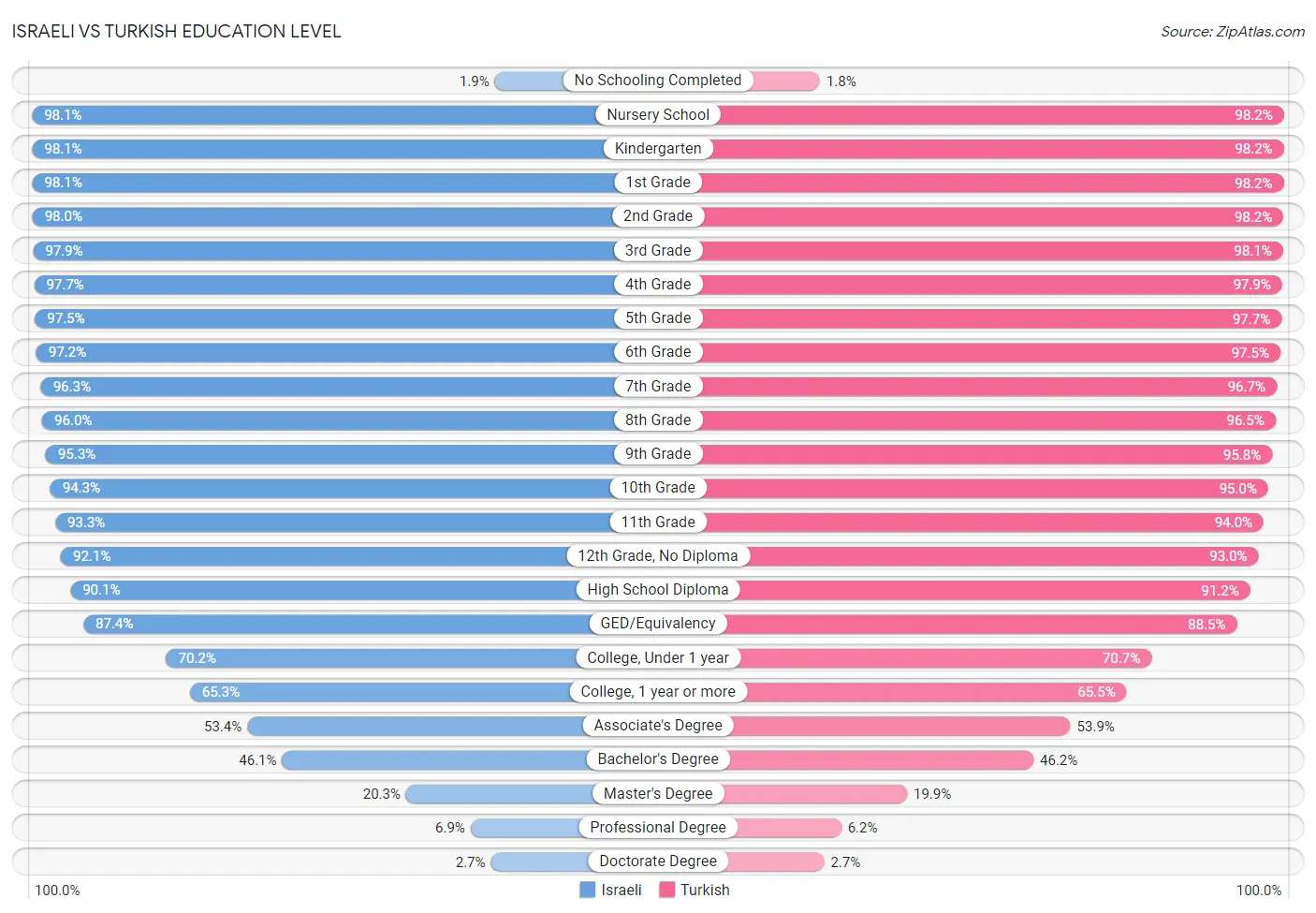
| Education Level Metric | Israeli | Turkish |
| No Schooling Completed | Exceptional 1.9% | Exceptional 1.8% |
| Nursery School | Excellent 98.1% | Exceptional 98.2% |
| Kindergarten | Excellent 98.1% | Exceptional 98.2% |
| 1st Grade | Excellent 98.1% | Exceptional 98.2% |
| 2nd Grade | Excellent 98.0% | Exceptional 98.2% |
| 3rd Grade | Excellent 97.9% | Exceptional 98.1% |
| 4th Grade | Excellent 97.7% | Exceptional 97.9% |
| 5th Grade | Excellent 97.5% | Exceptional 97.7% |
| 6th Grade | Excellent 97.2% | Exceptional 97.5% |
| 7th Grade | Excellent 96.3% | Exceptional 96.7% |
| 8th Grade | Excellent 96.0% | Exceptional 96.5% |
| 9th Grade | Exceptional 95.3% | Exceptional 95.8% |
| 10th Grade | Exceptional 94.3% | Exceptional 95.0% |
| 11th Grade | Exceptional 93.3% | Exceptional 94.0% |
| 12th Grade, No Diploma | Exceptional 92.1% | Exceptional 93.0% |
| High School Diploma | Exceptional 90.1% | Exceptional 91.2% |
| GED/Equivalency | Exceptional 87.4% | Exceptional 88.5% |
| College, Under 1 year | Exceptional 70.2% | Exceptional 70.7% |
| College, 1 year or more | Exceptional 65.3% | Exceptional 65.5% |
| Associate's Degree | Exceptional 53.4% | Exceptional 53.9% |
| Bachelor's Degree | Exceptional 46.1% | Exceptional 46.2% |
| Master's Degree | Exceptional 20.3% | Exceptional 19.9% |
| Professional Degree | Exceptional 6.9% | Exceptional 6.2% |
| Doctorate Degree | Exceptional 2.7% | Exceptional 2.7% |
Israeli vs Turkish Disability
When considering disability, the most significant differences between Israeli and Turkish communities in the United States are seen in self-care disability (2.4% compared to 2.2%, a difference of 8.2%), vision disability (2.0% compared to 1.9%, a difference of 4.0%), and ambulatory disability (5.7% compared to 5.5%, a difference of 3.3%). Conversely, both communities are more comparable in terms of male disability (10.3% compared to 10.3%, a difference of 0.15%), cognitive disability (17.0% compared to 16.9%, a difference of 0.39%), and disability age 18 to 34 (6.1% compared to 6.2%, a difference of 0.48%).
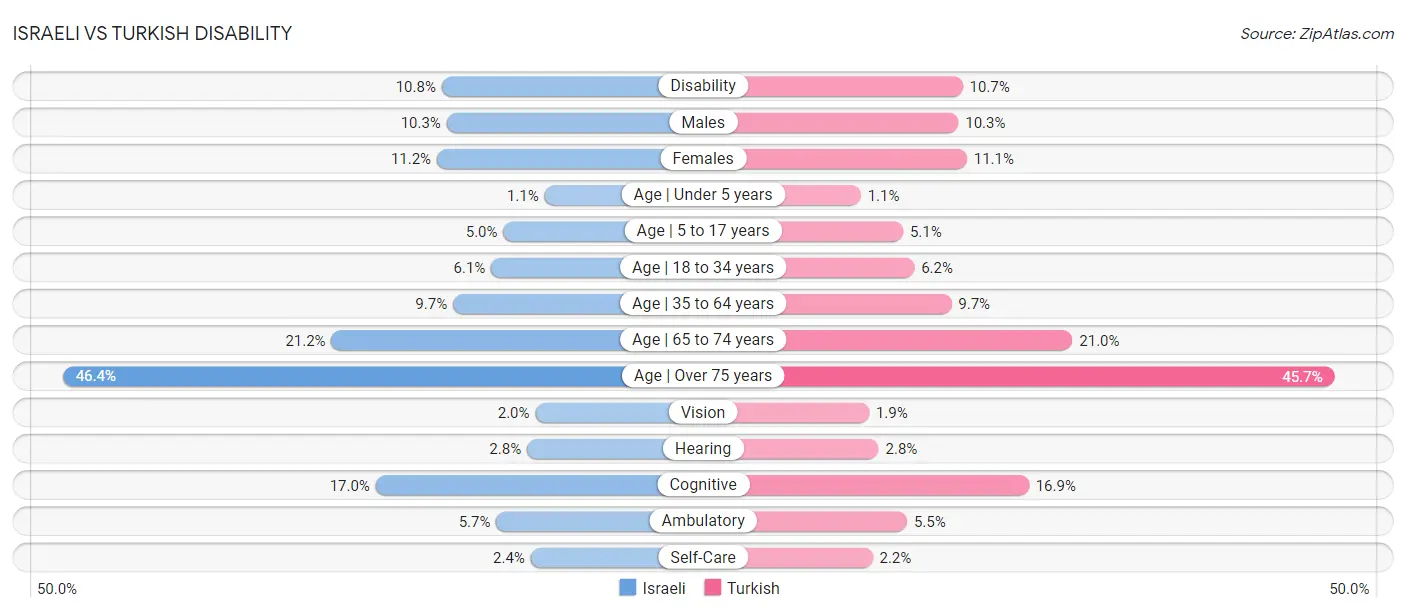
| Disability Metric | Israeli | Turkish |
| Disability | Exceptional 10.8% | Exceptional 10.7% |
| Males | Exceptional 10.3% | Exceptional 10.3% |
| Females | Exceptional 11.2% | Exceptional 11.1% |
| Age | Under 5 years | Exceptional 1.1% | Exceptional 1.1% |
| Age | 5 to 17 years | Exceptional 5.0% | Exceptional 5.1% |
| Age | 18 to 34 years | Exceptional 6.1% | Exceptional 6.2% |
| Age | 35 to 64 years | Exceptional 9.7% | Exceptional 9.7% |
| Age | 65 to 74 years | Exceptional 21.2% | Exceptional 21.0% |
| Age | Over 75 years | Exceptional 46.4% | Exceptional 45.7% |
| Vision | Exceptional 2.0% | Exceptional 1.9% |
| Hearing | Exceptional 2.8% | Exceptional 2.8% |
| Cognitive | Exceptional 17.0% | Exceptional 16.9% |
| Ambulatory | Exceptional 5.7% | Exceptional 5.5% |
| Self-Care | Good 2.4% | Exceptional 2.2% |